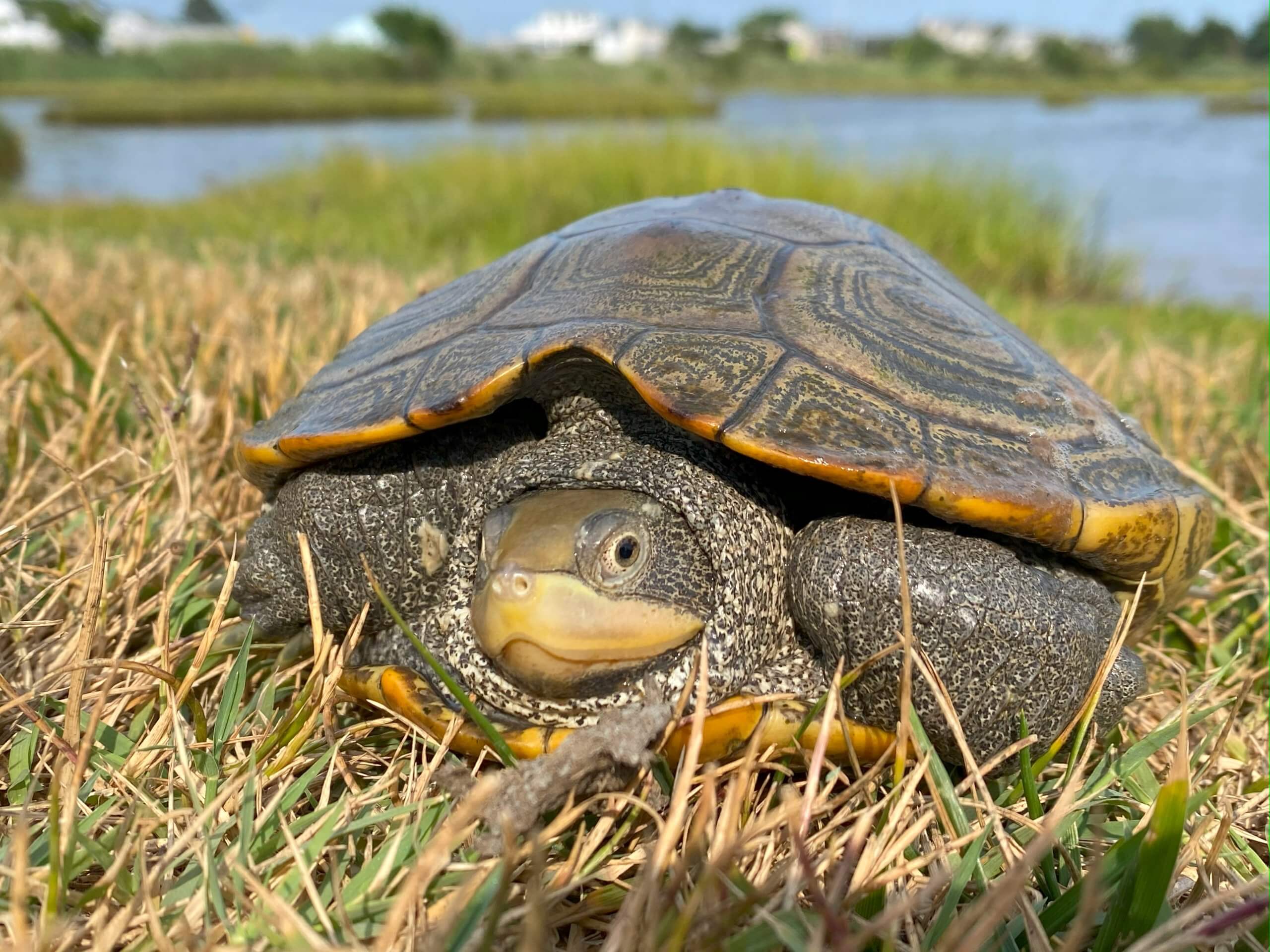Nesting Season a Good Reason for Drivers to Slow Down
STONE HARBOR — While Memorial Day is often referred to as the unofficial start to summer, it is the official start of nesting season for the area’s diamondback terrapins.
Signs along roads such as Stone Harbor Boulevard, Ocean Drive, Avalon Boulevard and other streets bordering the area’s marshes warn motorists of terrapin crossings and to slow down.
“The terrapin nesting season coincides with our peak tourism season of June and July, and into August,” said Brian Zarate, New Jersey Fish and Wildlife zoologist, whose specialty involves endangered and non-game species including terrapins.

“In our area, they often use the roads to get through the marshes to higher land, which is where they nest,” he said. “We want drivers to be aware that it’s peak season because what you are seeing on the road are the adult females, who keep the species alive by their breeding.”
Terrapins live in either fresh or brackish water and can also be found in waterholes, ponds or lakes. They tend to spend most of their time in the water but come on land to bask in the sun and occasionally burrow in mud. They often will nest on lawns, driveways or road shoulders, any place that is high and dry, all of which makes protecting them a challenge.
“It’s been a busy nesting season already,” said Brian Williamson, a research scientist at The Wetlands Institute, Stone Harbor, who noted that this year the nesting season started just before Memorial Day. He’s not sure yet how this season compares to last year’s in terms of numbers; however, he said the institute has noticed an increase in terrapin mortality due to an increase in traffic volume in the area.
Drivers Beware
Williamson said more nesting activity seems to occur in the morning and early afternoons, around 5 p.m. in the evening, and around high tides. “My main advice is to pay attention if you are on any of the causeways leading to our islands or any of our roads near the marshes,” he said. “Drivers should focus on the road, adhere to the speed limit and not tailgate, so if a terrapin is crossing the road, they can stop or swerve safely.”

When it’s safe, Williamson suggested helping a turtle cross the road in the direction it’s headed. “Don’t pick it up and drive it a mile away,” he said. “If you have to handle them, stay away from their face and front half of their body. They can bite, so you want to hold them from their sides or back.”
Zarate does not encourage people to handle terrapins, or to hose them off if it’s hot. “We encourage a hands-off approach as much as possible and encourage homeowners to use chicken wire to protect the nest if they have one,” he said. Under-road tunnels also help guide the terrapins to higher land.
Tracking Terrapins
The Wetlands Institute’s staff, along with volunteers, monitors what roads the terrapins are crossing and when, and collects data to help understand population sizes, longevity and what can be done to further protect the species.
This year, New Jersey is one of several northeastern states participating in a pilot program to learn more about the terrapin population. Using a tracking app through the state’s wildlife department, they are conducting head counts of the terrapins in the water or on land. Over time, the year-to-year numbers will give some indication of how healthy the species is.
The institute’s staff will attach GPS telemetry to track terrapin movement, adding the Delaware Bay area to the sampling. So far, Williamson said, the bay area is “unknown territory” in terms of terrapin nesting.

Since 1997, he said, about 7,000 terrapins have been tagged by the institute, each having a unique code, similar to a pet’s microchip, that provides data. “We know terrapins live long lives, and we still find some nesting who were tagged in 1997, so they are at least 35 years old, if not older,” he said. “Some of this data helps us to determine where to put turtle fences to keep them off the roads, if possible.”
The institute uses two main types of fencing: A corrugated tube that is about 80% effective when it is in good condition, and black, two-foot-tall plastic fencing with metal posts that is very effective.
“However, both of these are very expensive,” Williamson said, “so we have a funding issue and are always looking for donations and other ways to buy fencing. The fences also require manpower to put up, so we are always looking for volunteers.”
Terrapins are important to the salt marsh ecosystem that surrounds much of Cape May County. The marshes provide opportunities for fishing, boating, storm protection and tourism, Williamson said. The terrapins eat invertebrates like the marsh periwinkle snail, which, if left untouched, would overgraze and destroy the marsh ecosystem.
“They also are pretty to look at, and biologically are the only reptiles who live in the salt marshes. So they are very unique,” he added.
Besides cars hitting turtles and injuring or killing them, adult bald eagles and river otters are the main predators of adult terrapins, Williamson said. “Sometimes coyotes, foxes and even raccoons will try to kill a terrapin if they find one laying eggs.”
A Head Start
Zarate said that a female terrapin “can lay eight to 11 eggs up to three times a year. The female basically lays the nest, covers it up and leaves. It takes usually 60 to 90 days for the eggs to hatch, and only a small percentage of the clutch actually reaches adulthood because of all the predators and challenges within nature. Some hatchlings will stay close to the nest until spring, over-wintering in the nest.”
At the Wetlands Institute, there are a number of programs geared for terrapin protection, including one that is called a “head start” program. According to Devin Griffiths, marketing and communications specialist at the institute, if the staff finds a road-killed female that hasn’t dug her nest yet and still has eggs, they can remove the eggs and incubate them at the facility. Once they hatch, the staff brings many of them to Stockton University, where they are raised through the winter.
“Newly hatched terrapins are very small, around the size of a half-dollar coin,” Griffiths said. “Normally, when they emerge from their nests in the spring, they head out into the marsh, hide and hibernate through the winter.
“At a year old, they’re nearly the same size they were when they hatched, and are at high risk of being eaten by predators. The incubated hatchlings who end up at Stockton get fed through their first winter, though, so a year later, they’re about the size of a 3- or 4-year-old terrapin, considerably bigger and less likely to be eaten. Thus, they have a head start on life.

“Every year, we release these head-starters back into the marsh. We have both public and private releases for folks who have symbolically adopted a terrapin during the previous year.
“We also have a special release with the Stone Harbor Elementary School, where students join us for a morning and get the chance to return a terrapin to the marsh. During the school year, they sell cookies and donate the proceeds to us, and each year, Sturdy Savings Bank matches their donation.”
Griffiths said another program involves sending diamondback terrapin hatchlings to spend the school year with teachers who are trained and permitted to raise the turtles with their students through the Terrapins in the Classroom program. The hatchlings come from eggs saved from female terrapins killed on roads during the nesting season.
Elementary, intermediate and high schools from across the state are represented in the program, affording hundreds of students the chance to learn about the reptile through lessons integrating biology, conservation, wildlife, ecosystems, math and writing. At the end of the school year, the head-started terrapins are returned to the institute for release, and graduated to life in the marsh.
Protecting Terrapins
Zarate and Williamson said there are several things people can do to protect diamondback terrapins.
“First, be aware. These adult females are the most vulnerable because they are of reproductive age to keep the species growing,” Zarate said.

“Second, if you see a terrapin on the road, avoid it as safely as possible. I know some of the roads in the area are narrow, so slow down.
“Third, if there is a terrapin trying to cross the road, carefully and safely give it guidance if you can. If there is a median in the middle of the road preventing it from getting across, well, turn it around. Or you help it get across the road in the direction it is going and put it down safely on the side of the road.”
If a terrapin is struck or injured, there are a small number of people who can rehab it, the zoologist said, pointing to the state Department of Wildlife website or social media for information.
Williamson said people can also contact the institute for help finding a nearby licensed wildlife rehabilitator who can care for the injured terrapin.
He cautioned people who use commercial crab traps to check them often, as terrapins can be caught in them and drown. There are crab trap excluders available, and the institute can provide further guidance.
The state, at this time, has declared the northern diamondback terrapin a Northeast Regional Species of Greatest Conservation Need, Zarate said, which puts it on the radar for all northeastern states. It is being considered to be listed as a Species of Special Concern in New Jersey.
Contact the reporter, Karen Knight, at kknight@cmcherald.com.







